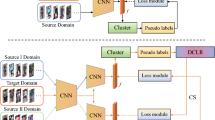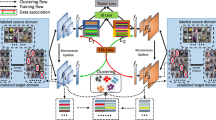Abstract
Domain generalization person re-identification (re-ID) is a more realistic task that aims to learn a model with multiple labeled source domains and generalize its inference to an unseen domain. However, under joint training of multi-source domains, some difficulties such as domain imbalance, domain shifts and small training batches not only influence the representation learning of the model but also lead to poor generalization performance. In this work, we enhance the generalization performance by proposing two strategies including knowledge accumulation and distribution enhancement for multi-source domain generalization person re-ID. Specifically, we encourage the learning of semantically significant features globally by establishing a simple but effective knowledge accumulation feature classifier (KAFC). In which, continuous learning guided by the label information explicitly provides stable prototype matching for each source domain, directly solving the problem that unstable parameter updates due to the small-batch data and source domain shifts. Secondly, to enhance the generalization ability and learn more robust representations, a multi-mix batch normalization (MMBN) module is introduced to generate the mixture features with cross-domain distribution information, where an approach based on the exponential moving average is adopted for capturing the domain distribution knowledge.
Extensive experiments on multiple widely-used benchmarks demonstrate that our method can effectively improve the generalization capability on unseen domains.





Similar content being viewed by others
Explore related subjects
Discover the latest articles, news and stories from top researchers in related subjects.Data availability
Dataset derived from public resources and made available with the article. The datasets analyzed during the current study are available in the [repository name Market1501] [https://doi.org/10.1109/ICCV.2015.133] reference number [40], [repository name DukeMTMC-reID] reference number [41], repository name CUHK03-NP] reference number [42] and [repository name MSMT17] [https://doi.org/10.1145/3394171.3413904] reference number [43].
References
Wang J, Lan C, Liu C, Ouyang Y, Qin T, Lu W et al (2022) Generalizing to unseen domains: a survey on domain generalization. Knowl Data Eng Trans. https://doi.org/10.1109/TKDE.2022.3178128
Song J, Yang Y, Song Y, Xiang T et al (2019) Generalizable person re-identification by domain-invariant mapping network. In: The IEEE Conference on Computer Vision and Pattern Recognition (CVPR). CVPR, pp 2288–2295
Zhao Y, Zhong Z, Yang F, Luo Z, Lin Y, Li S et al (2021) Learning to generalize unseen domains via memory-based multi-source meta learning for person re-identification. In: The IEEE Conference on Computer Vision and Pattern Recognition (CVPR). https://doi.org/10.1109/CVPR46437.2021.00621
Jin X, Lan C, Zeng W, Chen Z, Zhang L (2020) Style normalization and restitution for generalizable person re-identification. In: The IEEE Conference on Computer Vision and Pattern Recognition (CVPR). https://doi.org/10.1109/CVPR42600.2020.00321
Dai Y, Li X, Liu J, Tong Z, Duan L (2021) Generalizable person reidentification with relevance-aware mixture of experts. In: The IEEE Conference on Computer Vision and Pattern Recognition (CVPR). https://doi.org/10.1109/CVPR46437.2021.01588
Li P, Li D, Li W, Gong S, Fu Y, Hospedales TM (2021) A simple feature augmentation for domain generalization. In: International Conference on Computer Vision (ICCV), pp 8886–8895. https://doi.org/10.1109/ICCV48922.2021.00876
Zhou K, Yang Y, Qiao Y, Xiang T (2021) Domain generalization with mixstyle. In: International Conference on Learning Representations (ICLR). https://doi.org/10.48550/arXiv.2205.07211
Luo C, Song C, Zhang Z (2020) Generalizing person re-identification by camera-aware invariance learning and cross-domain mixup. In: Proceedings of the European Conference on Computer Vision (ECCV), pp 224–241. https://doi.org/10.1007/978-3-030-58555-6_14
Wang W, Liao S, Zhao F, Kang C, Shao L (2021) Domainmix: Learning generalizable person re-identification without human annotations. In: British Machine Vision Conference (BMCV). https://doi.org/10.48550/arXiv.2011.11953
Dou Q, Castro DC, Kamnitsas K, Glocker B (2019) Domain generalization via model-agnostic learning of semantic features. In: Advances in Neural Information Processing Systems (NIPS). https://doi.org/10.48550/arXiv.1910.13580
J Jia, Q Ruan, TM Hospedales (2019) Frustratingly easy person re-identification: generalizing person Re-ID. In: Practice. In: British Machine Vision Conference (BMVC). https://doi.org/10.48550/arXiv.1905.03422
D Ulyanov, A Vedaldi, V Lempitsky (2016) Instance normalization: the missing ingredient for fast stylization. arXiv:1607.08022. https://doi.org/10.48550/arXiv.1607.08022
Ioffe S, Szegedy C (2015) Batch normalization: accelerating deep network training by reducing internal co-variate shift. In: International Conference for Machine Learning (ICML). https://doi.org/10.48550/arXiv.1502.03167
Fan X, Wang Q, Ke J, Yang F, Gong B, Zhou M (2021) Adversarially adaptive normalization for single domain generalization. In: The IEEE Conference on Computer Vision and Pattern Recognition (CVPR), pp 8208–8217. https://doi.org/10.48550/arXiv.2106.01899
Seokeon C, Taekyung K, Minki J, Hyoungseob P, Changick K (2021) Meta batch-instance normalization for generalizable person re-identification. In: The IEEE Conference on Computer Vision and Pattern Recognition (CVPR). https://doi.org/10.1109/CVPR46437.2021.00343
Yu S, Zhu F, Chen D et al (2021) Multiple domain experts collaborative learning: multi-source domain generalization for person re-identification. arXiv:2105.12355. https://doi.org/10.48550/arXiv.2105.12355
Wu G, Gong S (2021) Collaborative optimization and aggregation for decentralized domain generalization and adaptation. In: International Conference on Computer Vision (ICCV), pp 6484–6493. https://doi.org/10.1109/ICCV48922.2021.00642
Shao R, Lan X, Li J et al (2019) Multi-adversarial discriminative deep domain generalization for face presentation attack detection. In: The IEEE Conference on Computer Vision and Pattern Recognition (CVPR). https://doi.org/10.1109/CVPR.2019.01026
Zhang H, Zhang Y, Liu W et al (2021) Towards principled disentanglement for domain generalization. arXiv:2111.13839. https://doi.org/10.48550/arXiv.2111.13839
Ko B, Gu G, Kim HG (2021) Learning with memory-based virtual classes for deep metric learning. In: The IEEE Conference on Computer Vision and Pattern Recognition (CVPR). https://doi.org/10.48550/arXiv.2103.16940
Huang X, Belongie S (2017) Arbitrary style transfer in real-time with adaptive instance normalization. In: International Conference on Computer Vision (ICCV). https://doi.org/10.1109/ICCV.2017.167
Tobin J, Fong R, Ray A, Schneider J, Zaremba W, Abbeel P (2017) Domain randomization for transferring deep neural networks from simulation to the real world. In: IEEE/RSJ International Conference on Intelligent Robots and Systems (IROS), pp 23–30. https://doi.org/10.1109/IROS.2017.8202133
Zheng K, Liu J, Wu W et al (2021) Calibrated feature decomposition for generalizable person re-identification. arXiv:2111.13945. https://doi.org/10.48550/arXiv.2111.13945
Liao S, Shao L (2020) Interpretable and generalizable person reidentification with query adaptive convolution and temporal lifting. In: European Conference on Computer Vision (ECCV), pp 456–474. https://doi.org/10.1007/978-3-030-58621-8_27
Ang E, Shan L, Kot AC (2021) DEX: domain embedding expansion for generalized person re-identification. arXiv:2110.11391. https://doi.org/10.48550/arXiv.2110.11391
Yassine H et al (2023) Video surveillance using deep transfer learning and deep domain adaptation: Towards better generalization. Eng Appl Artif Intell 119. https://doi.org/10.1016/j.engappai.2022.105698
K Hamza, Y Himeur, AI Awad (2023) Deep transfer learning for intrusion detection in industrial control networks: a comprehensive review. J Netw Comput Appl 220:103760
Pu N, Chen W, Liu Y et al (2021) Lifelong person re-identification via adaptive knowledge accumulation. arXiv:2103.12462. https://doi.org/10.48550/arXiv.2103.12462
Hou S, Pan X, Chen CL, Wang Z, Lin D (2019) Learning a unified classifier incrementally via rebalancing. In: The IEEE Conference on Computer Vision and Pattern Recognition (CVPR), pp 831–839. https://doi.org/10.1109/CVPR.2019.00092
Zhang C, Song N, Lin G et al (2021) Few-shot incremental learning with continually evolved classifiers. In: The IEEE Conference on Computer Vision and Pattern Recognition (CVPR). https://doi.org/10.1109/CVPR46437.2021.01227
Simon C, Faraki M, Tsai YH et al (2022) On generalizing beyond domains in cross-domain continual learning. In: The IEEE Conference on Computer Vision and Pattern Recognition (CVPR). https://doi.org/10.48550/arXiv.2203.03970
Rebuffi SA, Kolesnikov A, Sperl G, Lampert CH (2017) iCaRL: incremental classifier and representation learning. In: The IEEE Conference on Computer Vision and Pattern Recognition (CVPR). https://doi.org/10.1109/CVPR.2017.587
Wu G, Gong S (2021) Generalising without forgetting for lifelong person re-identification. Proc AAAI Conf Artif Intell 35(4):2889–2897
Ge W, Du J, Wu A et al (2022) Lifelong person re-identification by pseudo task knowledge preservation. Proc AAAI Conf Artif Intell 36(1):688–696
Yang Z, Wu D, Li B et al (2022) Joint plasticity learning for camera incremental person re-identification. arXiv:2210.08710
Deng J, Dong W, Socher R, Li LJ, Li K, Li F (2009) Imagenet: A large-scale hierarchical image database. In: The IEEE Conference on Computer Vision and Pattern Recognition (CVPR), pp 248–255. https://doi.org/10.1109/CVPR.2012.6248055
He K, Zhang X, Ren S et al (2015) Delving deep into rectifiers: surpassing human-level performance on imagenet classification. In: International Conference on Computer Vision (ICCV). https://doi.org/10.1109/ICCV.2015.123
He K, Zhang X, Ren S, Sun J (2016) Deep residual learning for image recognition. In: The IEEE Conference on Computer Vision and Pattern Recognition (CVPR), pp 770–778. https://doi.org/10.1109/CVPR.2016.90
Pan X, Luo P, Shi J, Tang X (2018) Two at once: Enhancing learning and generalization capacities via ibn-net. In: European Conference on Computer Vision (ECCV), pp 484–500
Zheng L, Shen L, Tian L, Wang S, Wang J, Tian Q (2015) Scalable person re-identification: a benchmark. In: The IEEE International Conference on Computer Vision (ICCV). https://doi.org/10.1109/ICCV.2015.133
Ristani E, Solera F, Zou R, Cucchiara R, Tomasi C (2016) Performance measures and a data set for multi-target, multi-camera tracking. In: Proceedings of the European Conference on Computer Vision (ECCV). Springer, Cham
Li W, Zhao R, Xiao T, Wang X (2014) Deep-reid: Deep filter pairing neural network for person re-identification. In: The IEEE Conference on Computer Vision and Pattern Recognition (CVPR), pp 152–159. https://doi.org/10.1109/CVPR.2014.27
Liu X, Zhang S (2020) Domain adaptive person re-identification via coupling optimization. In: Proceedings of the 28th ACM International Conference on Multimedia, pp 547–555. https://doi.org/10.1145/3394171.3413904
K Zhou, Y Yang, A Cavallaro et al (2021) Learning generalisable omni-scale representations for person re-identification IEEE Trans Softw Eng. https://doi.org/10.48550/arXiv.1910.06827
Zhuang Z, Wei L, Xie L et al (2020) Rethinking the distribution gap of person re-identification with camera-based batch normalization. European Conference on Computer Vision (ECCV). https://doi.org/10.1109/TCSVT.2021.3058111
Qi L, Wang L, Shi Y, Geng X (2022) A novel mix-normalization method for generalizable multi-source person re-identification. IEEE Trans Multimed (IEEE TMM). https://doi.org/10.48550/arXiv.2201.09846
L Qi, J Liu, L Wang et al (2023) Unsupervised generalizable multi-source person re-identification: A domain-specific adaptive framework, pattern recognition (PR)
Acknowledgements
This work was supported by the National Natural Science Foundation of China (No. 62172029 and No. 61872030).
Author information
Authors and Affiliations
Contributions
Author 1 (First Author): Conceptualization, Methodology, Software, Investigation, Validation, Formal Analysis, Writing—Original Draft;
Author 2(Corresponding Author): Conceptualization, Funding Acquisition, Resources, Supervision, Writing—Review & Editing.
Author 3: Supervision, Writing—Review & Editing;
Author 4: Investigation, Formal Analysis, Writing—Review & Editing.
Corresponding author
Ethics declarations
Competing interests
The authors declare that they have no known competing financial interests or personal relationships that could have appeared to influence the work reported in this paper.
Additional information
Publisher's Note
Springer Nature remains neutral with regard to jurisdictional claims in published maps and institutional affiliations.
Rights and permissions
Springer Nature or its licensor (e.g. a society or other partner) holds exclusive rights to this article under a publishing agreement with the author(s) or other rightsholder(s); author self-archiving of the accepted manuscript version of this article is solely governed by the terms of such publishing agreement and applicable law.
About this article
Cite this article
Peng, W., Chen, H., Li, Y. et al. Multi-source domain generalization peron re-identification with knowledge accumulation and distribution enhancement. Appl Intell 54, 1818–1830 (2024). https://doi.org/10.1007/s10489-024-05266-8
Accepted:
Published:
Issue Date:
DOI: https://doi.org/10.1007/s10489-024-05266-8




